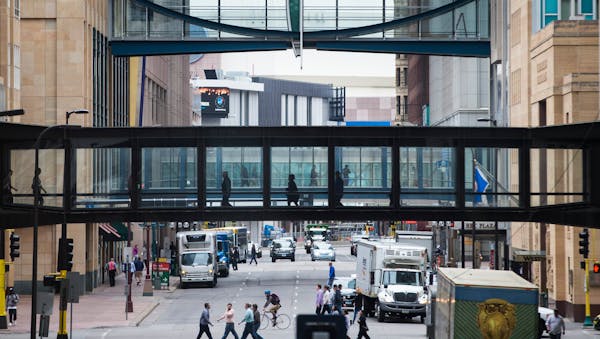Why can't Minnesotans figure out how to zipper merge?
Listen and subscribe to our podcast: Via Apple Podcasts | Spotify | Stitcher
Kate Thoma recently came upon a construction zone in Bloomington, and with traffic backed up in the left lane, she zoomed along in the unoccupied right lane until signs told her to move over.
She was zipper merging, but her efforts were thwarted by a left lane vigilante who would not let her in line.
"I'm certain he thought of me as rude and entitled, but I was just doing what my 9th grade driver's ed teacher taught me," Thoma said.
Indeed zipper merging is the law, but Thoma's experience prompted her to ask why Minnesotans can't zipper merge and why some motorists get all worked up when people do it. Two other Star Tribune readers sent in similar questions to Curious Minnesota, the newspaper's community-driven reporting project that invites readers to join the newsroom and ask the questions they want answered.
The Minnesota Department of Transportation in the early 2000s was the first in the nation to employ the zipper merge as a way to better manage traffic when a lane is closed in work zones. The concept is simple: Drivers remain in their respective lanes until they reach the designated merge point. Then, like we learned in kindergarten, drivers are supposed to take turns falling orderly in line.
"It's a great idea in theory, but theory is not how people always drive," said Dwight Hennessy, a traffic psychologist who teaches at Buffalo State College in New York. "Zipper works when everyone follows the rules — the system can handle the odd rule breaker — but typically when one person breaks those rules others often follow."
When people speed by in the open lane, that ticks people off as those waiting in line for a long time perceive those passing by as being impatient rule breakers sneaking to the front, Hennessy said.
"It's perceived unfairness," said MnDOT work zone engineer Ken Johnson. "If more people would use lanes to the merge point, fairness is taken care of."
That's been a big roadblock, and a major reason why MnDOT is still struggling to get motorists to adopt the maneuver even though it's included in the Minnesota Driver's Manual, Johnson said.
Research has shown that zipper merging reduces the queue of vehicles in the closed lane by 40 to 50 percent, Johnson said. It's also safer. When motorists use both lanes and merge late, traffic in both lanes generally moves at the same speed. That, Johnson says, curbs risky behaviors such as queue jumping in which drivers move from the slow lane into the fast lane and then cut back into the slow lane. It also reduces the risk of rear-end crashes, the most common mishap in construction zones, he said.
But that doesn't mean people do it. Many, Hennessy said, may be trying to be polite. Others have probably had bad experiences before. And that's when the merging battle begins.
Sometimes frustrated drivers take things into their own hands. Thoma has seen drivers intentionally blocking the open lane so nobody can pass.
That's a no-no, said Lt. Gordon Shank of the State Patrol, and a ticketable offense.
"People view it as cutting in line, and cutting in line is not 'Minnesota Nice,'" Thomas said. "It's not cutting in line. It's efficient."
Zipper merging in Minnesota is exclusively reserved for work zone bottlenecks, and not in situations such as when drivers use an "Exit Only" lane and then cut in at the last second instead of exiting.
"That is cheating. They are forcing themselves in," Johnson said.
Different rules for different situations. No wonder drivers are confused — and angry.
Minnesota drivers are not the only ones that struggle with how and when to zipper merge. In Kansas, where the take-your-turn-at-the-merge point technique has been employed occasionally over the past three years, the department of Transportation is shying away from using the zipper merge term and has resorted to telling drivers that merging early is incorrect.
"Drivers who are unaware or aggressive make it too difficult to use this process smoothly," said Laurie Arellano, a spokeswoman for KDOT.
The California Department of Transportation no longer uses zipper merging. It recommends drivers merge well before reaching a lane closure "because waiting can create opportunities for unsafe merging," said Alsia Becerra, a Caltrans spokeswoman. "Drivers who cut in at the last minute cause sudden stopping and lane changes which cause direct collisions."
Minnesota remains committed to using the zipper merge, and is continuing to teach drivers the proper and polite way to merge. Through YouTube videos and an entire resource guide on its website, Johnson said the agency continues to educate drivers.
Thoma thinks a massive marketing campaign might help, but then again, she said signs tell drivers to "use both lanes" and "take turns at merge" and motorists just ignore them.
"I love the zipper merge," Thoma said. "It's the law, and if everyone did it, we'd all be better off."
---
If you'd like to submit a Curious Minnesota question, fill out the form below:
Read more Curious Minnesota stories:
Why isn't Isle Royale a part of Minnesota?
Why does Minnesota tax Social Security benefits?
Why is Uptown south of downtown in Minneapolis?
What percentage of Minnesotans spend their entire lives here?
Were Minneapolis' skyways first created to combat the cold – or something else?
Why hasn't Minnesota ever produced a U.S. president?
How did Minnesota's indigenous people survive the extreme winters?


